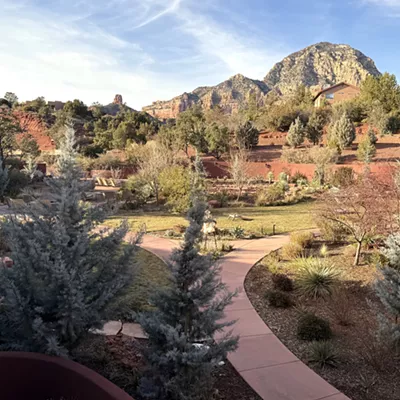A native Tucsonan and his partner, who was reared in Africa, would have you believe the latter. They are changing the way people all over the world, especially Americans, are looking at mesquite.
Dave Perino first began working with wood in the early 1970s in Tucson in a family-owned construction business with his father, Joseph Perino, and two brothers, Joe and Tom. In 1974, the business changed from contracting to wood fabrication during one of the city's building slumps.
Joseph Perino had a fondness for mesquite and, while working a construction job at a Cessna dealership at the airport, he suggested to the business owners they use mesquite from Mexico to produce entry doors.
In Mexico, the Perinos visited a boatyard in Puerto Peñasco that built shrimp boats out of mesquite. "They had some pretty crude saws. They didn't have to have anything real refined. But they had enough saws to get some lumber out of the trees," Dave said.
The Perinos were able to buy enough lumber, and Joseph Perino fashioned doors with push bars out of mesquite to look like the air foil of an airplane wing.
"That was 30 years ago and the doors are still on the same building," said Dave. "That kind of started our interest in mesquite."
His father was a retired Air Force colonel who had always wanted to be a woodworker. "He'd go out to the firewood pile, grab a piece of firewood and turn it into a lamp or bowl or what have you." remembered Dave. "From the time we were little kids we watched his woodworking hobby transform. He always felt there was something more to mesquite than fuel wood."
DAVE PERINO HEEDED the words of his father's to explore what he could do with mesquite by starting his own business during a Tucson building industry slump. A family friend's father had bought the Empirita Ranch between Tucson and Benson and mesquite was being cleared off it. Dave persuaded the owner to let him have access to the mesquite as it was being bulldozed off the land.
From that first salvaged mesquite Dave's own mesquite business began. He rented a store in Trail Dust Town near Pinnacle Peak Steak House on Tanque Verde.
"I used our construction yard and shack to build in during the days and sold bowls and cutting boards at night," remembered Dave.
"People would come out from having a mesquite steak dinner and walk right into this little shop selling mesquite goodies, so it was pretty successful and the shop opened doors to bigger and better things."
The Perinos had a sawmill on a rancher's land near Cascabel, which they began operating around 1976, and Dave said he always felt it would be nice to own some land down by the San Pedro River, where a thick, mature mesquite grove grows. In 1989, he purchased 40 acres. He began building a house and shop there and bought 80 more acres in '93.
At the time the Perinos were selling products they hoped would interest manufacturers in producing, items such as mesquite veneer mirrors, tables and flooring. "The concept was to generate the ideas and to get someone else to manufacture," said Dave.
Their goal of having other producers manufacture their ideas didn't work all that well. They'd hoped to have a line of fine mesquite products manufactured in the Midwest where wood items have been readily manufactured since the 1800s. But mesquite was not something Midwest sawmills and wood factories were accustomed to.
The short, scrubby nature of mesquite didn't look anything like the long-limbed walnut, tall oak, straight pine, or any of the other trees that had been logged and sent through sawmills there for generations. It was different.
"And it doesn't take much to be different to someone in Indiana," Dave said. "For 150 years, they'll tell you, this is the product they've been making; this is the raw material they've been making it from; you throw something like mesquite at them and they don't understand it."
So the Perinos brought their mesquite product ideas back to Arizona, set up a small plant in Oracle in the early 1990s and began producing a line of six different tables. One of the table designs, a dining room table with thick mesquite veneer, became a big success.
THE TABLE LINE GREW until the Perinos were unable to keep up with the demand and when an associate, Dick Dawson of Catalina, who was helping to run the business, died, the shop was closed. "We couldn't maintain and grow with our retailer, Crate and Barrel of Chicago. They wanted 10 times more than we could produce," said Dave.
Around this time, a woman named Kathryn Ehrhorn moved into the Cascabel neighborhood. Drawn there also by the mature mesquites that hug the banks of the San Pedro, Kathryn, who was reared in Africa, had been looking for a community-minded rural place in which to raise her two young sons.
She began working for Dave and "the first thing she saw was the food value of mesquite," said Dave. "This tree is not just wood, it has a capacity to rebuild soil and provide food."
Dave says he was aware of the mesquite pod's food value but was not then in a position to do anything about it. "It was just food for thought at that point," he said. Research was being funded at the time in Tucson by federal grants focused on the local Native American population's problem with diabetes.
Dave said there was mesquite pod meal available locally during the '90s, milled and provided by a few small businesses, but nobody was producing it commercially.
Until Kathryn came along. She had been living in Oro Valley. She said she was living at a beautiful place, Tangerine and La Cholla, and that she witnessed development encroaching and the community feeling powerless about doing anything but watch the beauty of their land being ruined.
Kathryn is not the type of woman who accepts people feeling powerless, in any situation. She said she started a newspaper to "empower people, to create a difference in the future of their community." The newspaper she founded, the Northwest Explorer, is still making a difference to its community.
"I was a single mom. I had a little 1-year-old and a 3-year-old, running a fledgling newspaper," said Kathryn, remembering the day she decided she needed to change something about her life. "The pre-school called one day and they were gonna kick out my baby for juvenile delinquincy and I realized, 'Oh, he doesn't have any parents, does he?' And I'm fighting this zealous battle with politicians and developers."
Kathryn said that she and her young sons went out looking for a dirt road. "I put the babies in the car and just went out cruising, looking for a dirt road, and that's how we found Cascabel."
She bought some land that suited her and her boys, and within 30 days of her search, she began building her own home, a yurt. It wasn't long before Ehrhorn saw the need for a community school (local kids were having to go to Benson for school, 35 miles away). So she began working towards the formation of a charter school.
"That turned out as much a fiasco for me as the newspaper business, I was still driving all over the place being the crazy, workaholic mother," she remembered. "My kids still didn't have a mom." She decided she could provide a better education for them by paying for their education herself instead of going the public school route.
She hired a couple of teachers to homeschool her sons and began working with Dave at San Pedro Mesquite Company, just down the road from the yurt she and her sons lived in. So began their partnership.
DAVE AND KATHRYN realized that what was keeping San Pedro Mesquite from growing larger was lack of a steady supply of lumbered mesquite. Mesquite grows abundantly in all arid regions of the world but there are few places, especially in the United States, where it is used for anything other than firewood or making charcoal.
Dave belonged to an association in Texas called "The Friends of the Mesquite." He said he didn't quite understand the politics surrounding mesquite but quickly saw there was an effort to keep the industry in Texas. The group, Dave said, was trying to convey a message "that mesquite was a Texas industry, it wasn't an international industry." At that time Dave didn't realize the abundance of mesquite worldwide.
At an annual meeting of the Texas group, Dave met a woman who had worked with the Peace Corp in Argentina. She told him she spent three years helping cooperatives in northern Argentina develop their mesquite resources. The light went on for Perino.
In '93 the couple traveled to Argentina, where they had the opportunity to interview hundreds of sawmill owners and mesquite producers and handpick those they wanted to produce for them "enormous amounts of mesquite," said Kathryn. They began importing their material. "Suddenly we could really play in this marketplace," said Dave.
They began dealing with huge amounts of mesquite, "20,000 square feet of flooring at a time, that we warehouse in Los Angeles, and drop-ship to customers all over the United States; supply is no longer a problem," said Kathryn.
"The first large factory that we went to in Argentina probably produced more mesquite product in a month than the entire Texas industry did in a year," said Dave.
Kathryn said they were amazed at what they saw in Argentina, that "all the funky little motels in the backwaters of all the jungles down there are furnished with huge mesquite headboards, and wardrobes, the floors, shutters, gates, all mesquite."
"We'd worked in Texas for 10 and 11 years. Oracle Panel had three different Texas suppliers, and they couldn't keep up with the supply. They were undercapitalized, mom and pop businesses, mortgaging the house or whatever to try and buy a mill and keep the production happening," said Dave.
But in Argentina, they found a whole new world. "Here was the raw material, here was the resource and an anxious supplier willing to take the financing to the next step. We planted some seed money. But they were willing to front the material. So they started the export for us and we started the import part of it and they were willing to sit on it. It took us two years to really get it rolling. We were starving," remembered Dave.
"We advertised heavily nationally in trade publications," said Dave. And they created an Internet Web site. Today, they don't ship without payment in full.
"You know the building business, everybody's trying to do it off of the bank's money. Nobody wants to come up with any dough to put a floor down, so it's like 'We'll pay you when the bank sends that portion of the money' and we've just never been able to afford to play that part of the building business," said Dave.
"So we just drew the line, made it payment in full and we'll ship tomorrow. And no one in the mesquite business has ever done that. They take half down and three months later say 'I don't know if we can produce it,' and it's been this horrible story for a long time."
But no more, because San Pedro Mesquite Company has become a reliable source of mesquite products for builders.
THE COUPLE SAID THE biggest obstacle they've had to overcome is the bad reputation of previous mesquite producers and brokers letting contractors down halfway through a project. "Being a builder, you can't make money unless you've got the goods. If you've sold something to a homeowner or to a commercial project, you've got to deliver."
So how is business today for San Pedro Mesquite?
"We did two air freights last week. One was a ton of flooring product and one was a half a ton. They went out on jets to the East Coast. We put in on a jet, why wait for a truck that takes seven days? It's $1,200 to air freight a small floor, a significant part of their flooring budget, but that's the market today," said Dave.
Kathryn added that, "It's a high-end niche product. That's an asset to our company. Ninety-five percent of the wood floors in the United States are oak. So, we're vying for a segment of that 5 percent of the hardwood industry. It starts at $7.50 a square foot for just the product, costs about $12-$15 a square foot fully installed.
"The physical properties (of mesquite) are fantastic. It's very stable, it doesn't shrink or expand; it's gorgeous, the grain patterns are so unique that, indeed, this customer base is willing to do what it takes to get it. And they're so happy that it's finally reliably available."
For 75 years in the United States ranchers have been trying to eradicate the mesquite. But, "Here's a tree you can't kill," said Kathryn. "It's too tenacious, and it produces a food, the seed pod, that's 20-30 percent protein, rich in lysines and amino acids, high in fiber, it's got the type of glucose that regulates the human body rather than spikes it (like sugar does). It grows without irrigation, without pesticides or fertilizers, it's awesome! Who wouldn't get excited about it!"
After adding mesquite pod meal to their Web site, sales have increased steadily. Spas and restaurants all over the country, from the Hyatt Regency in Phoenix to trendy vegetarian cafes in New York City are buying mesquite pod meal in ever-increasing amounts. One chef has gone on the road and is doing workshops on how to cook with the product and each workshop he holds sends more orders to San Pedro Mesquite.
"There's days here that the calls for mesquite flour are more than for the flooring and we do almost a million dollars a year in flooring," Dave said. "It's been like a wake-up call for us to figure out how to be in a position to capitalize and be a part of what's going to happen with the food aspect of mesquite." The flooring business of San Pedro Mesquite has been growing 5 to 6 percent per month for four years.
Kathryn and Dave were invited to South Africa to deliver a presentation to a group of scientists who were trying to control mesquite, or as they called it, their "invasive pest problem."
Dave said South African officials were worried about expanding mesquite groves. He said he and Kathryn suggested to the group, the best eradication, rather than all this chemical, biological research being funded, was to let the human hand exploit the resource.
"Texas has been eradicating mesquite for 65 years, serious money, billions of dollars spent to eradicate and they now have 20 percent more mesquite today than they did 65 years ago," said Dave.
KATHRYN SAID THE mindset against mesquite never ceases to baffle her. She said she met a farmer in St. David who told her he hates mesquite and that he spent $116,000 to remove it from his land. Bulldozed piles of mesquite now litter his land.
She said she suggested he spend $30,000 more and set up a small log processing business, employ local people and generate an income base of maybe a million a year.
And the farmer's reaction to this? Dave covered his ears and groaned "Ooo ooo ooo, they don't want to hear it, you know, 'Granddaddy hated them, daddy hated them and I hate them,' it's just too different."
Kathryn and Dave have been able to convince some ranchers, mostly in other countries, of the value mesquite can bring if it is approached with a different mindset, and as far as they are concerned, the shift in attitude comes none too soon.
"At some point in our history, other timber producers, the walnut, the oak, all of those people are headed on a collision course with degraded material. You talk to any lumber man and they'll tell you they don't get lumber like they used to get. You can't get boards that are straight and clear anymore because our forests have degraded," said Dave. "Here's the mesquite, that's always been gnarly and ugly and crooked and we've found ways to capitalize on the resource and utilize it."
Dave has maintained all along that all that is needed to make mesquite wood work in the manufacturing of products is a change in the tools used to produce it and a change in attitude on ways the wood is used. And finally, others are listening.
"We're already seeing small-log processing seminars and workshops where folks from more established timber species are saying 'Hey, we need to change our ways,'" said Kathryn.
"We spent $25,000 of our own money last year, sitting on a soapbox, taking trips, doing the whole thing. It was an expensive year. We'll probably do more of it because we realized we all owe something to our kids."
"We believe that mesquite will be the soybean of this century, the protein of the next generation," said Dave, as he took another bite of the mesquite pod meal banana bread Katherine had baked that very morning.






